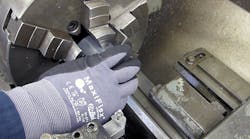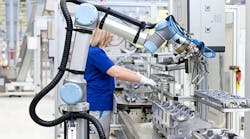Walking into a machine shop without proper training is putting yourself at risk. Machine shops might not be dangerous by design, but the nature of the tools and equipment involved in machining operations make it imperative that all personnel working in a machine shop environment be alert and well-trained.
Following here is a helpful review of employee training, personal considerations, and equipment safety practices, along with a how-to for correctly reporting an accident. It all starts with educating your team about how to stay safe.
Training — The vast array of equipment types present in machine shops is what makes it so dangerous. Many tools have sharp edges or powerful motors that can lead to injuries should a worker accidentally activate or adjust the machine.
You can avoid these accidents by making sure all members of your team thoroughly understand the equipment they work around.
The Occupational Health and Safety Administration requires specific training courses for many jobs, and you can arrange to have your team attend an online training course and evaluation, to ensure they all are up-to-speed on how their equipment functions, and the risks involved.
Personal safety — One thing you'll notice OSHA stresses in its training materials is the consistent use of personnel protective equipment. Even when an employee has significant experience, you can't make allowances — the gear has to stay on. In many cases, a dress code that disallows loose or baggy clothing is a good idea, too. This type of apparral can get caught in machines and catch fire quickly.
Common types of protective gear include eye protection, such as safety glasses or goggles, gloves for employees who work with hot or corrosive materials, and respirators for employees who work with equipment that creates high levels of particulate matter. In other settings, employees might need to wear knee pads or back braces.
When an employee is required to wear protective gear, he or she should be instructed on how to use it correctly. Misuse of protective equipment can negate its ability to protect your team.
Equipment safety — In addition to the initial level of training, each employee should have to understand the underlying functionality of all machines present in their shop. Employees should receive specialized training for the particular role they'll play and the equipment they’ll use.
For example, OSHA requires specialized training for forklift operators because of the immense power of these machines and the high number of accidents that occur when they’re in use. According to OSHA, 25% of forklift deaths are caused by an overturned forklift. To qualify for a role as a forklift operator, employees need specialized training and must accrue the appropriate number of hours behind the wheel.
Metalworking machines, such as lathes and CNC machine centers, also require specialized training. All operators should read thoroughly and understand the documentation for the device they’ll be using.
As fixed equipment, close attention should be paid to the working area around these machines. You can avoid accidents by keeping the floor surface clean, guarding all transmission parts and keeping your mill or lathe sharp to prevent dangerous jams.
Reporting accidents — The aim of OSHA guidelines and proper training is always to avoid accidents, but when they do happen it’s important that employees know the correct procedure to report and document them. (https://www.osha.gov/report.html) In the event of a serious or fatal accident, all employers covered under OSHA jurisdiction must report the accident by law.
Accidents that require reporting are any time there is a fatality, amputation, inpatient hospitalization, or loss of an eye. All employees should know the OSHA number to call, and it should be posted near workplace phones. The rule holds for injuries or fatalities that occur within 30 days of a workplace incident.
Exceptions to accident reporting regulations include accidents that occur in a motor vehicle on a public street or highway (not in a construction zone) or accidents where the employee is hospitalized for observation or diagnosis only.
Safe employees make happy companies
No one wants to work somewhere that's got a bad track record. Even if it takes a little extra time and effort, making sure your crew understands their job environment well, has the proper qualifications and is using protective gear is crucial to a productive workplace.
Failure to do these things won't just result in more accidents. It could lead to your business being shut down. OSHA doesn't take kindly to violations, fines are harsh and it only takes a single accident to violate government standards. Don't be foolish, make sure everyone in your shop knows how important safety is.
Megan Nichols is an amateur astronomer and environmentalist, and a writer on a wide range of scientific topics. Her recent columns have examined “on-demand” manufacturing and best practices for managing human workers and robots. Follow Megan on Twitter @nicholsrmegan.










